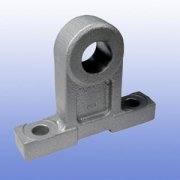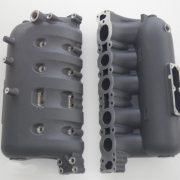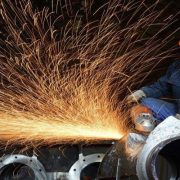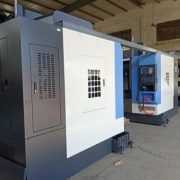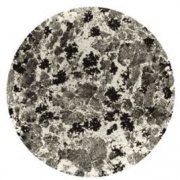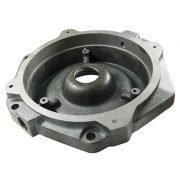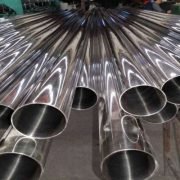The Difference between Pig Iron and Wrought Iron
/0 Comments/in Casting Article/by Yide CastingPig iron usually refers to an iron alloy with a carbon content of 2% to 4.3%, also known as cast iron. In addition to carbon, pig iron also contains silicon, manganese, and small amounts of sulfur and phosphorus. Pig iron cannot be forged, but it can be cast. According to the different forms of carbon, pig iron fall into steelmaking pig iron, cast pig iron and ductile iron.
1. Steelmaking pig iron
The carbon in steel-making pig iron exists in the form of carbides and has a white cross-section, usually called white iron. Steelmaking pig iron is hard and fragile, so it is usually used as a raw material for cast steel.
2. Cast pig iron
The form of carbon in cast pig iron is graphite flakes, which break into gray. Thus usually called gray iron. Because graphite is soft and has lubricity, it has good cutting, wear and casting properties. However, its anti-bit strength is insufficient. Therefore it cannot be forged. Gray iron is only used to make castings, such as casting various machine tool beds, iron pipes, etc.
3. Ductile iron
The carbon in spheroidal graphite cast iron exists in the form of spherical graphite. Meanwhile, its mechanical properties are far superior to gray cast iron, and are close to cast steel. It has excellent casting, machining and wear resistance, and has a certain degree of flexibility. Therefore, ductile cast iron has been widely used in the manufacture of crankshafts, gears, pistons and other high-grade castings as well as various mechanical parts.
In addition to the above, there are some iron alloys, which contain a lot of silicon, manganese, nickel or other elements, such as ferrosilicon, ferromanganese and so on. These ferroalloys are commonly used as raw materials for cast steel. Using these alloys, cast steel can obtain better physical properties.
Cast iron with a carbon content of less than 0.2% is called wrought iron or pure iron. Cast iron with a carbon content of 0.2-1.7% is called cast steel. Therefore, cast steel is a special kind of cast iron. The carbon content of more than 2% is called pig iron. Wrought iron is very soft, plastic and easily deformed. However, its strength and hardness are low, so it has not been widely used.
YIDE casting is a professional casting foundry, specialized in cast iron since 1993s. We can provide both casting and machining service for casting parts. If you are interested in our casting service, please feel free to contact us for more details.
How to Calculate the Weight of Iron and Steel Castings
/0 Comments/in Casting Article/by Yide CastingCast Iron Gear Castings
/0 Comments/in Casting Article/by Yide CastingCast Iron Gear Castings
Cast iron materials have many applications, one of which is very common is the manufacture of open transmission gears.
Gray cast iron has graphite material, which can play a certain lubricating effect during work and greatly reduce friction. At the same time, gray cast iron has low cost and good processing performance. Therefore, it is widely used in the production of gears.
Gray cast iron gears are often used in gear system structures with low load carrying capacity, low transmission speed, and low impact resistance. But with a compact design. There are also ductile cast iron gears, which can be used in closed drive systems.
Ductile cast iron has good comprehensive mechanical properties, good process performance and low price,. That means it is an excellent material for manufacturing gears. At present, there are many application examples of ductile iron gears used in automobiles, tractors, agricultural machinery, machine tools. And there are also automobile rear axle spiral bevel gears, tractor transmission gears and so on.
Cast iron gears have higher requirements for wear resistance. Whereupon surface quenching treatment is required. This is very important to ensure the comprehensive performance of cast iron gears.

Gray Iron Material Grades Choosing Guide
/0 Comments/in Casting Article/by Yide CastingThis guide will help gray cast iron buyers understand how to select the appropriate gray cast iron material grades for their casting products.
1. Which grey cast iron grades can you choose?
The table below shows all gray iron material grades in each country. So, if you are American, then you can choose No. 20, 30, 35 or 45, etc. If you are Australian, then you can choose T150, T220, T260 or T300, etc.
|
No. |
Country |
Gray Iron Material Grades |
||||||
|
1 |
China |
HT100 |
HT150 |
HT200 |
HT250 |
HT300 |
HT350 |
— |
|
2 |
Japan |
FC100 |
FC150 |
FC200 |
FC250 |
FC300 |
FC350 |
— |
|
3 |
USA |
— |
NO.20 |
NO.30 |
NO.35 |
NO.45 |
NO.50 |
NO.60 |
|
4 |
Russia |
C Ч1 0 |
C Ч 15 |
C Ч 20 |
C Ч 25 |
C Ч 30 |
C Ч 35 |
C Ч 40 |
|
5 |
Germany |
— |
GG15 |
GG20 |
GG25 |
GG30 |
GG35 |
GG40 |
|
6 |
Italy |
G10 |
G15 |
G20 |
G25 |
G30 |
G35 |
— |
|
7 |
France |
— |
FGL150 |
FGL200 |
FGL250 |
FGL300 |
FGL350 |
FGL400 |
|
8 |
England |
100 |
150 |
200 |
250 |
300 |
350 |
— |
|
9 |
Poland |
— |
Z115 |
Z120 |
Z125 |
Z130 |
Z135 |
Z140 |
|
10 |
India |
— |
FG150 |
FG200 |
FG260 |
FG300 |
FG350 |
FG400 |
|
11 |
Romania |
— |
FC150 |
FC200 |
FC250 |
FC300 |
FC350 |
FC400 |
|
12 |
Spain |
— |
FG15 |
FG20 |
FG25 |
FG30 |
FG35 |
— |
|
13 |
Belgium |
FGG10 |
FGG15 |
FGG20 |
FGG25 |
FGG30 |
FGG35 |
FGG40 |
|
14 |
Australia |
— |
T150 |
T220 |
T260 |
T300 |
T350 |
T400 |
|
15 |
Sweden |
O110 |
O115 |
O120 |
O125 |
O130 |
O135 |
O140 |
|
16 |
Hungary |
— |
OV15 |
OV20 |
OV25 |
OV30 |
OV35 |
OV40 |
|
17 |
Bulgaria |
— |
Vch15 |
Vch20 |
Vch25 |
Vch30 |
Vch35 |
— |
|
18 |
ISO |
100 |
150 |
200 |
250 |
300 |
350 |
— |
|
19 |
COPANT |
FG100 |
FG150 |
FG200 |
FG250 |
FG300 |
FG350 |
FG400 |
|
20 |
China Taiwan |
FC100 |
FC150 |
FC200 |
FC250 |
FC300 |
— |
— |
|
21 |
Holland |
— |
GG15 |
GG20 |
GG25 |
GG30 |
GG35 |
— |
|
22 |
Luxembourg |
— |
FGG15 |
FGG20 |
FGG25 |
FGG30 |
FGG35 |
FGG40 |
|
23 |
Austria |
— |
GG15 |
GG20 |
GG25 |
GG30 |
GG35 |
— |
2. What is the role of material grade?
The material grade comes from its specific material standard. For example, in the United States, the general material standard for ductile iron is ASTM A48. In this standard, you can find No.25 mechanical properties with the minimum tensile strength. 172 Mpa, No. 30 tensile strength 207 Mpa.
Therefore, when you tell us what material grade you need, we will know what mechanical properties you need, and then we can produce your castings accordingly.
3. How to choose the right grade of gray iron?
Choosing a gray iron material grade is a very professional job. Usually only a professional material engineer can choose the right grade. However, if you are not a material engineer but have to make a choice, then the following methods may help you.
- A. Please check the two-dimensional drawing, as well as your technical requirements, and then you may find some clues about the “material”, the finished drawing should indicate the material grade.
- B. If you cannot find any important information in the drawings, you may need to consider it based on your experience. The following experience will help you.
- B1. If you only need gray cast iron or cast iron and have no special requirements on its mechanical properties, you can choose “No.20 or No.25” (the equivalent grades in other countries are GG15, EN-GJL) -150, T150, 150 , HT150). The material equivalent table above will help you.
- B2. If the material needs high strength, high strength, and can withstand larger load forces, you can choose “No. 30” or higher grade “No. 35” (for equivalent grades, please refer to the material grade table above)).
- B3. If you need materials with very high strength, need to withstand very high pressure loads, and need to be very strong, then you can choose “No.40” or “No.45”.
On this point, let me explain. For some products, such as stove parts, high material grades will bring some difficulties to further drilling work, so do not require high grades for these parts, higher grades will lead to higher production costs and higher defect rates. So unless you really need it, the lower grades will be better used for casting production.
4. Some important issues in choosing gray iron material grades
For most foundries in China, we can produce low and medium gray cast iron material grades, but not everyone can produce high gray cast iron grades, such as No. 50 or No. 60. They need further heat treatment, so if you need very high resistance Tensile strength, but does not require the special mechanical properties of gray cast iron, and nodular cast iron material can be considered, which is stronger and tougher than gray cast iron.
If you still cannot make a good choice, then you can seek the help of some material engineers, or tell us your requirements. You just need to tell us where your parts will be used and what your application requirements are, and then we will give you our suggestions.
ASTM A216 Standard Specification for Carbon Steel Castings
/0 Comments/in Casting Article/by Yide CastingASTM A352 Standard Specification for Carbon Steel Castings
/0 Comments/in Casting Article/by Yide CastingAbout Yide Casting
Yide Casting is a professional casting & machining factory in China, specialized in green sand casting and clay sand casting. Otherwise, Yide casting has our patent JM heat exchanger for air conditioner…Read more.
Friendly link:
Contact information
- phone num:
+8613566559986 - WhatsAPP/ WeChat:
+8613566559986 Kevin - Email:
[email protected] - Address:No. 1328 Wenyi West Road, Cangqian Street, Yuhang District, Hangzhou Zhejiang
Service
Yide casting provides casting & machining service, which is a one-stop solution of casting parts.
Casting: green sand casting, shell sand casting
Machining.

